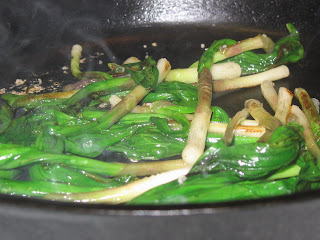
The artichoke that strange Mediterranean thistle that gives us its flower bud to ponder.
Artichokes are one of the foods when you see it makes you wonder - thick, fibrous leaves (they are really petals) with prickly thorns that can be annoying. Who would have ever thought to try one and how did they not bore by the time they reached its heart. Ah, the heart blanketed with a bed of choking hairs hiding it from us. The plant itself makes me think of a pray mantis – it looks like one to my eye.
It is import to buy artichokes that are tightly packed buds with unblemished petals. I always squeeze the artichoke before I purchase it to make sure it is tight and dense to the touch. The looser it is and the more the petals have started to spread open the more likely the “choke” is going to be well developed. I love the tiny three-bite-little-buds that I find off and on during the season. These small artichokes have a very meager choke that barely gets in my way, so all I have to do is trim their tops for the thorns have yet to show themselves.
Regardless of the size of your artichoke always have a lemon, halved, by your side. Whenever I make a cut in an artichoke I immediately rub the area down with the cut lemon to prevent it from browning. Continuing along that line when I cook the artichoke I always put lemon juice or white vinegar in the water from the same reason. A useful tip is to use a lid from a pot smaller than the one the artichokes are in to keep the artichoke submerged in its cooking liquid. The artichoke will take between ten 10 to 20 minutes to cook.

Roasted Artichokes - yields 4 servings
16 to 20 baby artichokes
2 lemons - zested and juiced (1 lemon just cut in half for rubbing on the artichoke)
1/4 cup olive oil
1 small red onion - sliced julienne
1 small carrot - diced
1/2 cup Balsamic vinegar
1/8 cup pine nuts - lightly toasted
1 bunch Italian parsley - leaves only, chopped (approx. 1/2 cup)
Salt and black pepper to taste
Prepare the baby artichokeby peeling away the bottom leaves, and trimming the base to expose the whitish flesh. Rub all places where you have made a cut with some lemon to prevent browning. Cut off the top of the artichokes to remove the thorny leaves and then rub with lemon. In a four quart pot filled with enough water to cover the artichokes, and the juice of a lemon place the artichokes, and bring to a boil. Lay a plate over the artichokes to keep them submerged in the water, once again, this will help prevent them artichokes from browning. Simmer for 15 minutes or until tender. Drain and cool.
Pre-heat the oven to 350 degrees.
Coat a roasting tray with the oil, and spread the artichokes in a single layer out onto the tray. Put in the oven, and roast for 10 minutes. Add the onions and carrots and roast for another 10 minutes. Remove the roasting tray from the oven, and immediately transfer the artichokes and onions to a mixing bowl. While it is still hot pour over the Balsamic vinegar, carrot, pine nuts, parsley, lemon zest and salt and pepper to taste. Mix well, and serve either hot or cold.
Stuffed Artichokes – yields 8 servings
1 1/2 cups bread crumbs
1/2 cup grated Pecorino Romano cheese
4 garlic cloves – peeled and finely minced
3 plum tomatoes – seeded and diced
1/4 cup basil leaves – chopped
2 tablespoons mint leaves – chopped
2 tablespoon Italian Parsley leaves – chopped
1 teaspoon salt
1/2 teaspoon black pepper
8 artichokes
2 lemons – cut in half
1/2 cup extra virgin olive oil
In a clean work bowl mix the bread crumbs, cheese, garlic, tomatoes, basil, mint, parsley, salt and pepper together to mix thoroughly.
Pre heat the oven to 350 degrees.
Trim the stem base of the artichokes so it will sit upright. Every time you make a cut on the raw artichoke you want to rub it with the lemon. This will prevent the artichoke from browning.
With a pair of scissors cut the carefully cut the thorny tips of the artichokes. Remove the first layer or two of the much tougher out petals of the artichokes. Again, rub the artichokes with the cut lemon.
Gently, tease apart the petals of the artichokes, and divide the bread crumb mixture among them.
Place the artichokes in a shallow baking pan, and drizzle each artichoke with a tablespoon of olive oil. Pour 2 cups of water in the baking pan, and cover with aluminum foil. Bake the artichokes for 1 hour.
Serve with lemons wedges.








































